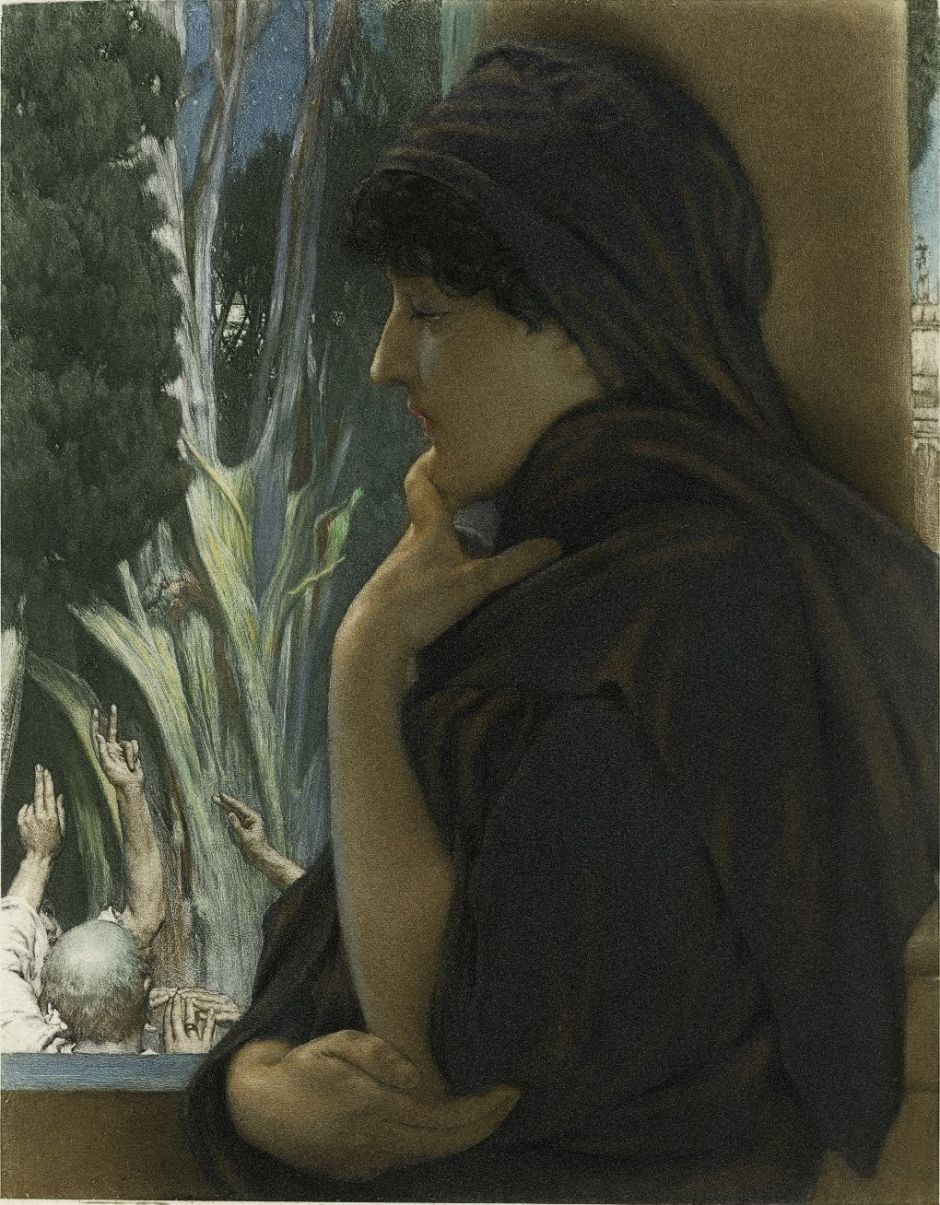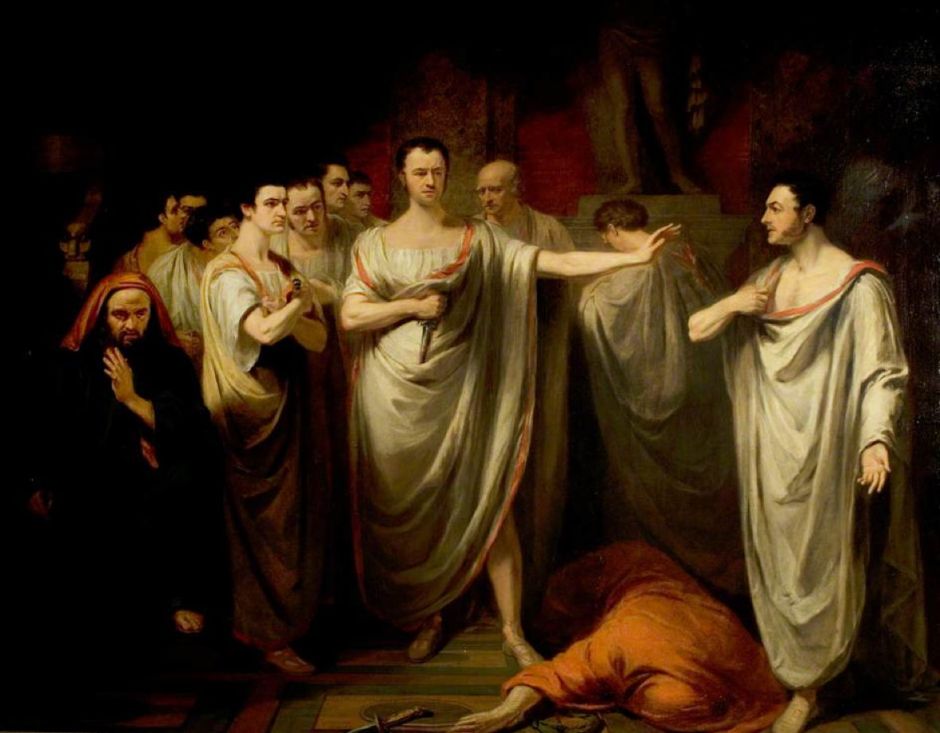The best-known account of the assassination of Julius Caesar is that given by Plutarch, but the only words we remember are those of William Shakespeare’s dramatisation in The Tragedy of Julius Caesar. He probably wrote this in the first half of 1599, and its first recorded performance was in September of that year.
Shakespeare takes a few liberties with Plutarch’s account, most notably compressing what occurred over a period of about two months into what appear to be successive days. As Plutarch’s Lives was one of the reference works relied on by many history painters, and Caesar’s assassination was a popular theme among those biographies, it’s hard to disentangle paintings referring primarily to Plutarch’s account from those made in response to Shakespeare’s play.
Caesar is celebrating the festival of Lupercal in Rome when a soothsayer warns him to beware of the Ides of March. When Caesar leaves, Brutus and Cassius discuss their fear that he could be proclaimed king after his victory over Pompey in the civil wars. Caesar returns and asks Antony privately why Cassius appears discontent. Casca then tells Cassius and Brutus how Caesar had three times refused a crown offered to him by Antony, and how the tribunes Murellus and Flavius have been condemned to death for removing decorations draped on Caesar’s images. Cassius decides to encourage Brutus to engage in the growing conspiracy against Caesar.
Later, Casca tells Cicero then Cassius about the omens he has seen, causing Cassius to admit him to the plot against Caesar. Cassius and Casca go to Brutus to persuade him to join them. Just as Brutus has decided the assassination of Caesar is the only way ahead, Casca and Cassius arrive with other conspirators, and Brutus, refusing to take a formal oath, shakes their hands and agrees the plan for tomorrow, the Ides of March. They decide not to kill Caesar’s friend Antony, though.
When the conspirators have departed, Portia, Brutus’ wife, begs her husband to tell her what’s going on. She shows him a wound in her thigh she inflicted on herself to prove she could withstand torture to preserve any confidence.

Although Elisabetta Sirani’s painting of Portia Wounding her Thigh from 1664 is more likely to have drawn on Plutarch than Shakespeare, it’s a remarkable work by this accomplished woman Master.

One of Lawrence Alma-Tadema’s paintings included in the published Graphic Gallery of Shakespeare’s Heroines shows Portia (wife of Brutus) (1896).
The following day, the Ides of March, Caesar orders an animal to be sacrificed to address the ill omens, but it proves to have no heart. Antony’s wife has dreamed of Caesar’s murder, and persuades him not to go to the Capitol, until Decius assures him that the Senate is going to crown him king. Brutus and the other conspirators arrive to accompany Caesar to the Capitol.
Casting aside the soothsayer’s reminder of his warning, and a cautionary letter, Caesar enters the sequence of events leading to his death. Antony is led out of the way, then Caesar is petitioned unsuccessfully for the repeal of a senator’s brother’s banishment. The other conspirators kneel in support, and Casca buries his dagger into Caesar, followed rapidly by the rest of the conspirators, with Brutus last of all. Caesar dies after uttering his last words, “Et tu Brutus?” (“you too, Brutus?”).

William Holmes Sullivan’s undated painting of The Assassination appears slightly confused, in that the swords of the conspirators are bloodied but Caesar remains propped up, bleeding against a large plinth, and pointing an accusative finger, presumably as he utters those last words.
The other senators flee, leaving the conspirators washing their hands in Caesar’s blood, intent on declaring their act in the Forum. Antony returns and invites them to kill him too. He then shakes their hands and looks forward to hearing their explanation. Brutus invites him to speak at Caesar’s funeral, but when Antony is left by himself he vows revenge.
Brutus tells the plebeians that, much as he loved Caesar, he had to kill him to maintain the liberty of the country. He hands over to Antony, who starts his oration with the memorable opening, “Friends, Romans, countrymen, lend me your ears” before praising Caesar’s virtues. He then shows the people Caesar’s body and inspires them to attack his murderers. Brutus and Cassius flee the city, and Antony goes to Caesar’s house to meet Octavius and Lepidus there.

George Clint’s painting of The Murder Scene from 1822 shows Antony, at the right, inviting the conspirators to kill him too. Apparently this includes portraits of three famous actors in John Kemble’s production at the Theatre Royal in Drury Lane, London, on 22 April 1822.
As citizens riot, attack those they incorrectly presume to have been among the conspirators, and burn houses down, Antony and Octavius start to muster forces to counter those being raised by Cassius and Brutus. The latter two argue over allegations of bribery before Brutus reveals that his wife Portia has killed herself because of her anxiety.
Brutus overrules Cassius to decide that their forces will march immediately to fight with those of Antony and Octavius at Philippi. When the others are asleep, Caesar’s ghost visits Brutus and promises to meet him at Philippi.

This engraving of Richard Westall’s painting Brutus and the Ghost of Caesar, from about 1802, shows Brutus in his role of general, sat at a writing desk, as Caesar’s ghost fills the upper left of the painting, warning Brutus of his imminent death with the words Thou shalt see me at Philippi.

William Blake painted a similar scene in his Brutus and Caesar’s Ghost from 1806, for an extra-illustrated folio edition of Shakespeare from 1632. This series of illustrations for this play are not well-known among Blake’s work, and were made early in his career.

Alexandre Bida’s undated painting of Brutus Sees Caesar’s Ghost has Brutus rising from his desk on the right, as Caesar’s ghost, wearing a laurel crown, points towards Philippi and Brutus’ fate there.

Edwin Austin Abbey, in his painting Within the Tent of Brutus: Enter the Ghost of Caesar from 1905, spatters the white robe of the ghost with the blood from multiple stab wounds.
The four leaders meet together at Philippi, where Antony and Octavius force Brutus and Cassius into immediate fighting. The latter two agree to kill themselves if they’re defeated. There is great confusion in battle: although the forces of Brutus do well against those of Octavius, Cassius’ army struggles against that of Antony. When Cassius’ servant reports that they are surrounded by cavalry, Cassius is convinced that he has lost, and has himself killed. It then turns out that the cavalry were those of Brutus.
As Brutus sees defeat imminent, he asks those with him to kill him, telling them that he has seen Caesar’s ghost again and knows his death is imminent. Only one is prepared to hold Brutus’ sword to allow him to run upon it, declaring in his last words that he killed Caesar less willingly. When Octavius and Antony find his body, they speak of his virtues, and praise his motives as being higher than those of the other conspirators.
References
Wikipedia on Shakespeare’s play.
Full text at Project Gutenberg
Michael Dobson and Stanley Wells (eds) (2015) The Oxford Companion to Shakespeare, 2nd edn, Oxford UP. ISBN 978 0 19 870873 5.

